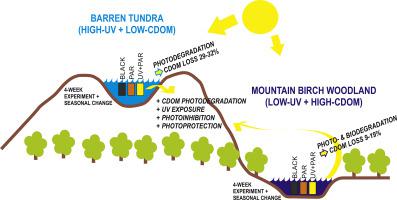Journal of Photochemistry and Photobiology B: Biology ( IF 5.4 ) Pub Date : 2020-06-11 , DOI: 10.1016/j.jphotobiol.2020.111932 Liisa Nevalainen 1 , Marttiina V Rantala 2 , E Henriikka Kivilä 1 , Andrea Lami 3 , Maxime Wauthy 4 , Milla Rautio 5 , Tomi P Luoto 1

|
Solar ultraviolet radiation (UV) induces photodegradation of optically and functionally important organic compounds in lakes and may negatively impact aquatic biota. We disentangled UV impacts on dissolved organic matter (DOM) transformation, and algal and zoobenthic micro-organisms in two shallow subarctic lakes in NW Finnish Lapland; in a high-UV + low-DOM (tundra, Iso-Jehkas) and a low-UV + high-DOM (mountain birch woodland, Mukkavaara) system. In addition to site and seasonal comparisons, in situ experiments with three treatments (DARK, photosynthetically active radiation [PAR], UV + PAR) were set up floating on the lakes for four weeks during midsummer. Lake water and experimental lake water were analyzed for basic limnology, optical properties (dissolved organic carbon [DOC], specific UV absorbance [SUVA], colored DOM [CDOM], and DOM compounds) as well as for photosynthetic and photoprotective pigments in algae and microzoobenthos. DOC concentrations remained largely unchanged after the exposure period in seasonal and experimental samples in both lakes yet the biochemical composition of the carbon pools was distinctly altered. CDOM and SUVA decreased seasonally and under UV exposure in the experiments, and terrestrial DOM compounds decreased in the experiments, suggesting UV induced photodegradation of large molecular size DOM of terrestrial origin. Higher seasonal and experimental (UV + PAR vs. PAR) proportional CDOM degradation occurred in Iso-Jehkas (32%, 29%) than in Mukkavaara (19%, 9%). Accordingly, the high-UV + low-DOM lake was more sensitive to photodegradation despite originally low CDOM relative to the low-UV + high-DOM system where DOM biodegradation likely prevailed. Experimental results showed elevated algal carotenoid/chlorophyll ratios and microzoobenthic melanin under UV exposure indicating photoinhibition and photoprotective pigmentation. UV has a significant impact on aquatic food webs of subarctic lakes altering the biogeochemical composition of organic matter and organisms through mechanisms of photodegradation, photoinhibition and photoprotection.
中文翻译:

北极亚湖泊对紫外线辐射的生物地球化学和光生物学反应。
太阳紫外线(UV)会诱导湖泊中光学和功能上重要的有机化合物发生光降解,并可能对水生生物造成负面影响。我们解开了紫外线对芬兰西北拉普兰两个浅亚北极湖中溶解性有机物(DOM)转化以及藻类和兽底微生物的影响;在高紫外线+低DOM(苔原,Iso-Jehkas)和低紫外线+高DOM(白桦林,Mukkavaara)系统中进行。除现场和季节比较外,仲夏期间,还设置了三种处理(DARK,光合有效辐射[PAR],UV + PAR)的原位实验,在湖面上漂浮了四个星期。分析了湖水和实验湖水的基本物性,光学特性(溶解的有机碳[DOC],比紫外线吸收率[SUVA],有色DOM [CDOM],和DOM化合物),以及藻类和微动物的光合作用和光防护色素。在两个湖泊的季节性和实验性样品中,暴露期后DOC浓度基本保持不变,但碳库的生化组成发生了明显变化。在实验中,CDOM和SUVA在季节性和紫外线照射下呈季节性下降,而在实验中陆地DOM化合物减少,这表明紫外线诱导了陆地来源的大分子DOM的光降解。Iso-Jehkas(32%,29%)发生的季节性和实验性(UV + PAR vs. PAR)比例CDOM降解率高于Mukkavaara(19%,9%)。因此,尽管最初的CDOM相对于可能进行DOM生物降解的低UV +高DOM系统低,但高UV +低DOM湖对光降解更敏感。实验结果表明,在紫外线照射下,藻类类胡萝卜素/叶绿素的比例和微囊性黑色素均升高,表明具有光抑制作用和光保护性色素沉着作用。紫外线对北极湖的水生食物网具有重大影响,它通过光降解,光抑制和光保护机制改变了有机物和生物的生物地球化学组成。



























 京公网安备 11010802027423号
京公网安备 11010802027423号